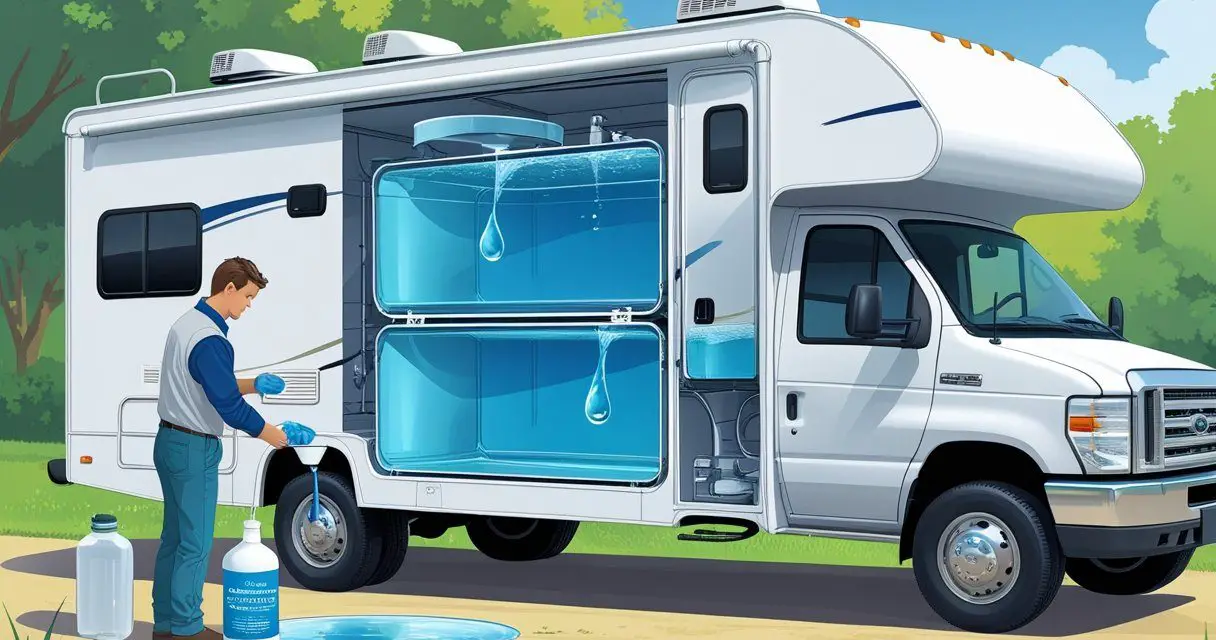Would you like to save this article?
If you spend time in an RV, you know how important it is to keep the waste tanks clean and odor-free. With so many products on the market, you might wonder if Rid-X, a common septic treatment, works for RV tanks.
Yes, you can use Rid-X in RV tanks, but only in small amounts and with the right type of product.
Rid-X contains bacteria and enzymes that break down waste and toilet paper, which can help prevent clogs and reduce bad smells. However, RV holding tanks are not the same as home septic systems, so using too much Rid-X or the wrong formula can upset the balance inside your tank.
That’s why knowing how and when to use it makes all the difference. Before you pour anything into your system, it helps to understand both the benefits and the limitations.
You’ll also want to know about other safe options that can keep your RV tanks working properly without causing long-term issues.
Key Takeaways
- Rid-X can be used in RV tanks if applied in small, proper amounts
- It may help with odor control and waste breakdown but has limits
- Other treatments and good maintenance habits can work just as well or better
Understanding Rid-X and Its Intended Use
Rid-X is designed as a septic tank treatment that supports waste breakdown and helps maintain septic system function. It relies on natural bacteria and enzymes to speed up decomposition of common household waste materials like toilet paper, fats, and proteins.
What Is Rid-X?
Rid-X is a commercial septic tank treatment created to help septic systems operate efficiently. It was originally marketed for residential use, where waste stays in underground tanks for long periods.
You typically add it through the toilet, and it moves into the septic tank. Once inside, it introduces bacteria and enzymes that target common waste materials.
This process can reduce buildup and help prevent clogs or backups. Over time, Rid-X has expanded into different forms, including powders, liquids, and gel packs.
The company also developed an RV-specific version since RV holding tanks differ from traditional septic systems. Unlike a septic tank, your RV black tank is emptied more often, so the way Rid-X functions may not be the same.
How Rid-X Works
Rid-X works by adding billions of active bacteria and natural enzymes into the waste system. These organisms break down waste materials into smaller, simpler substances that are easier to move and less likely to cause blockages.
The bacteria need water and favorable conditions to activate. Once in the tank, they multiply within a few days, helping maintain a balance that supports ongoing waste breakdown.
In a septic system, this action is useful because waste remains in the tank for weeks or months. In an RV tank, however, waste is usually dumped after a much shorter time.
This means Rid-X may not always have enough time to reach its full effectiveness in an RV setting.
Ingredients in Rid-X
Rid-X uses a mix of enzymes and bacteria, each with a specific role:
- Cellulase – breaks down toilet paper and plant fibers
- Lipase – breaks down fats, oils, and grease
- Protease – breaks down proteins from food and waste
- Amylase – breaks down starches and carbohydrates
These enzymes target the most common materials that cause buildup in septic systems. The bacteria then continue the process by digesting the broken-down waste.
This combination is what makes Rid-X effective for long-term septic system maintenance, though its results in RV tanks may vary depending on how often you empty them.
Can Rid-X Be Used in RV Tanks?
Rid-X can be used in RV holding tanks, but its effectiveness and safety depend on how you apply it. The product is designed for septic systems, so you need to pay attention to dosage, frequency, and the type of Rid-X you choose.
Applicability for RV Holding Tanks
Rid-X was originally made for home septic systems, but many RV owners use it in black tanks and portable toilets. It can help break down toilet paper and waste, while also reducing odors when used correctly.
You can find it in different forms, such as liquid, powder, or pellets. Some versions, like Rid-X Holding Tank Deodorizer, are marketed for odor control and are easier to use in RVs.
One important detail is that RV tanks are not the same as septic tanks. Septic systems rely on long-term bacterial activity, while RV tanks are emptied more often.
Because of this, Rid-X may not provide the same long-term benefits in an RV as it does in a home system. Still, many RVers use Rid-X as a supplement to regular RV tank treatments.
It can be useful if you want an affordable and widely available option for reducing smells and softening waste.
Safety Considerations
You should use Rid-X with caution in RV tanks. While it is generally safe, using too much or too often can upset the natural balance of bacteria in your black tank.
This can slow down waste breakdown and even increase odors. Some Rid-X products are stronger than others.
The septic system versions can be too aggressive for RV holding tanks, while the deodorizer versions are milder and better suited for short-term use.
Another point to consider is that Rid-X is not always necessary. Many RV owners manage their tanks with plenty of water, enzyme-based cleaners, or mild soaps like Dawn.
These alternatives avoid the risk of disrupting helpful bacteria. If you decide to use Rid-X, make sure you choose a product that matches the needs of your RV tank and avoid overuse.
Recommended Dosage and Frequency
The common guideline for RV use is about 3 ounces of Rid-X mixed with 1 gallon of water. This mixture is usually enough for a standard black tank.
You should pour it down the toilet and let it sit in the tank for a few hours before dumping. Use Rid-X sparingly.
Adding it every time you empty your tank is not recommended. A treatment once in a while is usually enough to help reduce odors and soften waste.
Too frequent use can reduce the effectiveness of the natural bacteria in your tank. Instead, balance chemical treatments with regular flushing and plenty of water.
If you want a simpler option, you can also use Rid-X Holding Tank Deodorizer packets. These are pre-measured and designed for portable toilets and RV tanks, making them easier to manage without worrying about dilution.
Benefits of Using Rid-X in RV Tanks
Rid-X can help manage common issues in RV holding tanks by reducing odors, breaking down waste, and offering a simple treatment method. It works differently than chemical deodorizers since it relies on bacteria and enzymes to target the source of the problem rather than just masking it.
Odor Control
One of the biggest challenges in RV black tanks is controlling unpleasant smells. Rid-X holding tank deodorizer uses natural bacteria that target waste and toilet paper, which helps reduce the gases that cause strong odors.
Unlike chemical RV toilet treatments that often cover up smells with fragrances, Rid-X works by breaking down the material that produces the odor in the first place. This makes it a practical option if you want fewer artificial scents inside your RV.
Odor control depends on how long waste sits in the tank. Since RV tanks are usually emptied more often than septic systems, results may vary.
If you tend to keep your tank full for a week or longer before dumping, you may notice more consistent odor reduction.
Waste Breakdown Efficiency
Rid-X contains enzymes like cellulase, lipase, protease, and amylase, which target different types of waste:
| Enzyme | Breaks Down |
|---|---|
| Cellulase | Toilet paper, plant matter |
| Lipase | Fats, oils, grease |
| Protease | Proteins |
| Amylase | Starches |
This mix helps soften and liquefy material in your black tank, making dumping easier and reducing the chance of clogs.
Because RV holding tanks are not true septic systems, the bacteria may not have as much time to multiply before you empty the tank. Even so, many RVers report fewer problems with stuck waste and better tank flow when using Rid-X as part of their holding tank treatment routine.
Ease of Use and Cost
Rid-X is simple to add to your RV toilet. You can choose from liquid, powder, or gel packs, and all forms dissolve into the black tank with water.
This makes it less messy than some treatments that require mixing or measuring multiple chemicals. You also don’t need large amounts.
A small dose, often just a few ounces with water, is enough for a typical tank. This can make it cost-effective compared to other RV holding tank treatments that require frequent or heavier applications.
If you prefer not to buy special RV toilet paper, Rid-X can help break down standard household brands, saving you money and avoiding the need for more expensive “RV-safe” paper. This combination of convenience and lower ongoing cost makes it appealing for long-term use.
Potential Drawbacks and Limitations
Using Rid-X in an RV tank can work in some situations, but it is not always the best fit. The way the product functions in a septic system does not always translate well to the unique setup of an RV black tank.
Differences in bacteria growth, storage time, and product design all affect results.
Impact on Beneficial Bacteria
Rid-X is designed to boost bacteria in a septic tank, where waste stays long enough for microbes to break it down. In an RV black tank, waste is usually dumped more often, so bacteria may not have enough time to grow and work effectively.
If you use Rid-X too frequently, it can upset the balance of microorganisms. Some reviews note that overuse may even reduce the natural bacteria already present in the tank.
That can make odor control harder instead of easier. It’s also worth noting that not every RV tank needs bacterial additives.
Many RVers manage their tanks with regular flushing and water use alone, which avoids the risk of disrupting microbial activity.
Effectiveness for Short-Term Waste Storage
A septic system holds waste for weeks or months, giving enzymes and bacteria time to break down solids. An RV black tank is different because you usually empty it every few days or weeks.
This shorter cycle limits how much breakdown can actually occur. While Rid-X starts working within hours, the bacteria need several days to multiply and reach full strength.
If you dump your tank before that, you may not see much benefit. For short-term storage, mechanical cleaning methods like tank flushing or using more water often provide faster, more reliable results than bacterial treatments.
Product Formulation Differences
Rid-X offers both septic tank treatment and an RV-specific version. The regular septic formula is made for large, underground tanks with steady waste input.
The RV black tank has a smaller capacity, limited water use, and different materials. Using the standard septic treatment in an RV may not cause harm, but it is not tailored for that environment.
The RV-specific formula is designed to work in portable toilets, RV tanks, and marine systems. Here’s a quick comparison:
| Product | Designed For | Best Use |
|---|---|---|
| Regular Rid-X | Household septic system | Long-term waste breakdown |
| Rid-X RV Formula | RV and marine tanks | Short-term odor control, easier dumping |
Choosing the right version matters because RV tanks need faster results and safer ingredients for plastic components.
Alternatives to Rid-X for RV Tank Treatment
You can choose from a range of products designed specifically for RV holding tanks, as well as natural or homemade solutions. Each option works in different ways to control odor, break down waste, and keep your tank sensors clear.
Popular RV-Specific Treatments
Many RVers prefer treatments sold specifically for RV black and gray tanks. These products are formulated to work in tanks that get emptied often, unlike septic treatments that rely on long-term bacterial growth.
Common RV holding tank treatments include Thetford Aqua-Kem, Camco TST, and Walex Porta-Pak. These are usually enzyme-based or chemical-based packets or liquids that you drop into your toilet with water.
They help control odors quickly and break down toilet paper so it flows out smoothly during dumping. Some are formaldehyde-free, which is better for campground septic systems.
When choosing a treatment, look at whether it reduces odor, breaks down solids, and is safe for the plumbing and seals in your RV.
Comparison with Products Like Happy Camper
Happy Camper RV Holding Tank Treatment is a popular alternative to Rid-X. Unlike enzyme products that rely on bacteria, Happy Camper uses a mineral blend that neutralizes odors on contact.
You only need a small scoop mixed with water to treat a standard 40-gallon tank. Many RVers like that it works in both hot and cold weather and does not leave a chemical smell.
Here’s a quick comparison:
| Feature | Rid-X (RV version) | Happy Camper |
|---|---|---|
| Base | Bacteria/enzymes | Mineral blend |
| Works best in | Warm temps, longer holding times | Any temp, short or long holding |
| Odor control | Slower, bacteria-based | Immediate, neutralizes odors |
Happy Camper can also be used in gray tanks, which helps prevent sink and shower odors.
Natural and DIY Options
If you want a simple option, you can use household products. A mix of baking soda and vinegar can help reduce odors and loosen buildup.
Adding a few drops of dish soap before driving can also help clean the tank walls as the liquid sloshes around. Some RVers use a mixture of water softener (Calgon) and detergent to keep solids from sticking to the tank.
This method is often called the “Geo Method.” The most important step is using plenty of water with every flush.
Water helps waste break down naturally and prevents clogs better than any additive alone. These DIY choices are inexpensive and easy to find, but they may not be as effective at odor control as commercial RV toilet treatments.
Tips for Maintaining RV Holding Tanks
Keeping your RV holding tanks in good condition requires the right dumping habits and consistent cleaning. Attention to what experienced RVers and manufacturers recommend helps prevent odors, clogs, and sensor issues.
Proper Dumping and Cleaning Practices
Always dump your black tank before your gray tank. This allows the soapy water from the gray tank to help rinse the sewer hose.
A clear sewer adapter is useful because it lets you see when the water runs clean. Keep at least a few gallons of water in the black tank after dumping.
This prevents waste from sticking to the sides and bottom. Without liquid, solids can dry out and create buildup that is difficult to remove.
If your RV has a built-in black tank flush, use it regularly. If not, a flushing wand or swivel stick can help rinse the tank walls.
Many owners also run extra water through the toilet after dumping to reduce leftover residue. Consistent cleaning keeps sensors more accurate.
When sensors get coated with waste, they often give false readings. A good rinse after each trip reduces this problem.
Community Insights and Recommendations
RV forums and owner groups often share practical advice based on long-term use. Members of the Winnebago, Monaco Owners Club, and Newmar Owners Club frequently stress the importance of water use.
Adding extra water after each flush helps keep solids moving and prevents clogs. Some RVers recommend using enzyme-based treatments like Happy Campers or Rid-X’s RV version.
Others prefer simple methods, such as adding a bit of dish soap to help break down grease. The RV community often points out that tank treatments are not a substitute for proper dumping and rinsing.
On forums, you’ll also find discussions about toilet paper. Many owners report success using regular household brands, as long as they dissolve quickly.
Special “RV toilet paper” is not always necessary, but testing a small amount in water before use can help you decide.
Manufacturer Guidelines
RV manufacturers provide specific guidance on tank care. For example, Winnebago and other brands recommend using plenty of water with each flush and avoiding harsh chemicals that could damage seals or valves.
They also stress using the correct fittings and hoses when dumping. Some manuals caution against using products designed for septic systems unless they are labeled safe for RV use.
Rid-X has an RV-specific formula, which is more suitable than the household version. Always check the product label before adding anything to your tank.
Manufacturers also note that tanks should not be left dry for long periods. Keeping a small amount of water in both black and gray tanks prevents odors and helps maintain seals.






